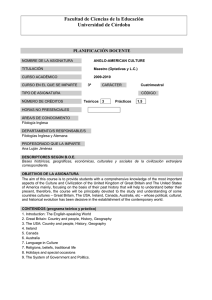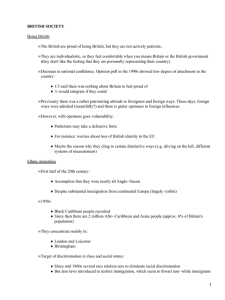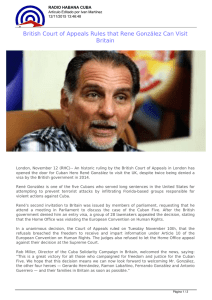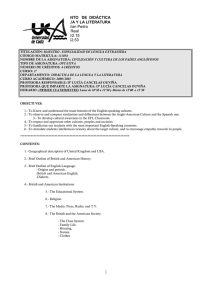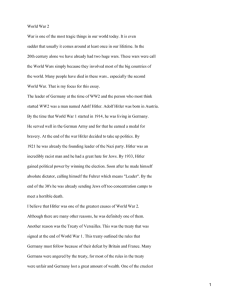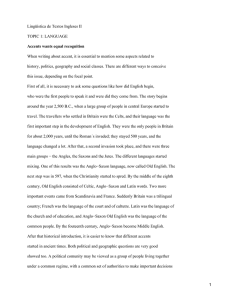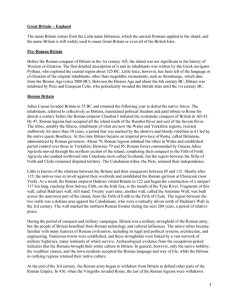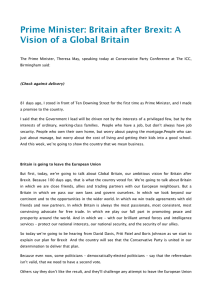BTA`s Cool Britannia: British national identity in the new
Anuncio
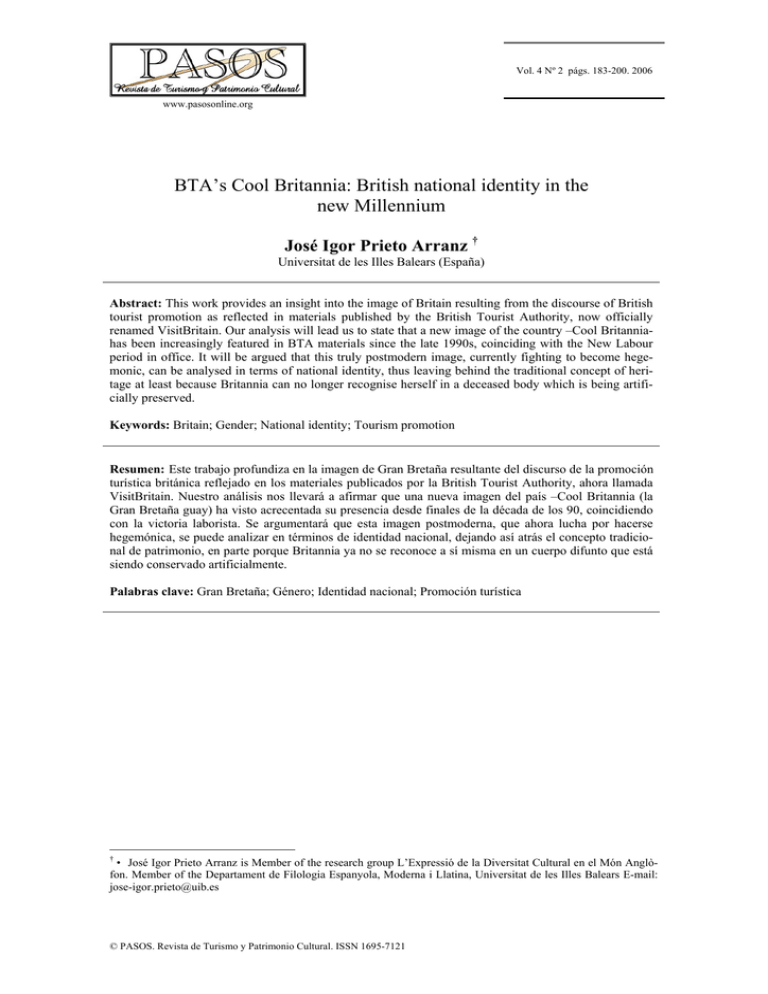
Vol. 4 Nº 2 págs. 183-200. 2006 www.pasosonline.org BTA’s Cool Britannia: British national identity in the new Millennium José Igor Prieto Arranz † Universitat de les Illes Balears (España) Abstract: This work provides an insight into the image of Britain resulting from the discourse of British tourist promotion as reflected in materials published by the British Tourist Authority, now officially renamed VisitBritain. Our analysis will lead us to state that a new image of the country –Cool Britanniahas been increasingly featured in BTA materials since the late 1990s, coinciding with the New Labour period in office. It will be argued that this truly postmodern image, currently fighting to become hegemonic, can be analysed in terms of national identity, thus leaving behind the traditional concept of heritage at least because Britannia can no longer recognise herself in a deceased body which is being artificially preserved. Keywords: Britain; Gender; National identity; Tourism promotion Resumen: Este trabajo profundiza en la imagen de Gran Bretaña resultante del discurso de la promoción turística británica reflejado en los materiales publicados por la British Tourist Authority, ahora llamada VisitBritain. Nuestro análisis nos llevará a afirmar que una nueva imagen del país –Cool Britannia (la Gran Bretaña guay) ha visto acrecentada su presencia desde finales de la década de los 90, coincidiendo con la victoria laborista. Se argumentará que esta imagen postmoderna, que ahora lucha por hacerse hegemónica, se puede analizar en términos de identidad nacional, dejando así atrás el concepto tradicional de patrimonio, en parte porque Britannia ya no se reconoce a sí misma en un cuerpo difunto que está siendo conservado artificialmente. Palabras clave: Gran Bretaña; Género; Identidad nacional; Promoción turística † • José Igor Prieto Arranz is Member of the research group L’Expressió de la Diversitat Cultural en el Món Anglòfon. Member of the Departament de Filologia Espanyola, Moderna i Llatina, Universitat de les Illes Balears E-mail: jose-igor.prieto@uib.es © PASOS. Revista de Turismo y Patrimonio Cultural. ISSN 1695-7121 184 Introduction. Aims and corpus gathered The aim of the present work is to provide an insight into the image of Britain resulting from the discourse of British tourist promotion as reflected in materials1 published by the British Tourist Authority (BTA), now officially renamed VisitBritain. With this aim in mind, a corpus of texts was gathered whose heterogeneity is illustrative of the vast array of materials published by BTA. The texts included in our corpus are listed below and were mostly available to the general public during the years 2000 and 2001 (subgroups have been made for ease of exposition). 1.1. Texts promoting Britain addressing a general audience and published in several languages, including Spanish. -BTA [trans. unknown] 1998: Gran Bretaña. Cómo planificar sus vacaciones. London: BTA. MG/SPA/99 ISBN 0 7095 7027 9. -BTA [trans. unknown] 1999a: Gran Bretaña. Cómo planificar sus vacaciones. London: BTA. MG/SPA/00 ISBN 0 7095 7160 7. -BTA 1999b: Britain. Millennium edition. London: BTA. No ISBN available. This text, distributed in North America, only promotes England. -BTA 2000a: Britain. Vacation planner 2001. London: BTA. MG/USA/01 ISBN 0 7095 / 7340 5. This is the standard American text available throughout the 2001 campaign. -BTA [trans. unknown] 2001a: Gran Bretaña. Información turística. London: BTA. M2BRGSP ISBN 0 7095 74673. 1.2. Texts targeting low-budget travellers. -BTA 1999c: Britain on a budget. Boston: Student Advantage, LLC. No ISBN available. It addresses a young, student American audience. -BTA [trans. unknown] 2001b: Gran Bretaña a buen precio. London: BTA. M2BFLSP ISBN 0 7095 7445 2. 2.3. Materials targeting an essentially young audience. -BTA 1999d: UK The guide. London: BTA. No ISBN available. -BTA 2000b: UK The guide 2001. London: BTA. ISSN 1464-5769. -BTA [Byword trans.] 2000c: UK The guide 2001. London: BTA. ISSN 1464-5769. Although the same title and ISSN numbers PASOS. Revista de Turismo y Patrimonio Cultural, 4(2). 2006 BTA’s Cool Britannia: ... are maintained, the copy of this text is in Spanish. 2.4. Materials targeting the 55+ segment. -BTA 2000d: Britain – Time to travel. New York: BTA. ISNBN 0 7095 7333 2. 2.5. Other materials promoting more specific areas or aspects of Britain. -BTA [Byword trans.] 2001c: Londres. Mapa y guía. London: BTA. ISBN 0 7095 7493 2 M2LMGSP. -BTA 2000e: UK city culture. London: BTA. ISBN 0 7095 7303 UKCC/2000. -BTA 2000f: The best of new Britain. London: BTA. ISBN 0 7095 7248 4 ENG/00. -BTA [trans. unknown] 2001d: Gran Bretaña. Información útil 2002. London: BTA. M2FACSP ISBN 0 7095 7438 X. Although far from comprehensive, our corpus is varied enough so as to show the wide range of materials published by BTA. In order to overcome such expectable limitations, some relevant BTA internet resources were duly accessed (see below) so as to guarantee that the conclusions reached are indeed relevant and do not apply exclusively to a minor percentage of BTA publications. A new Britain? The analysis of the texts above enables us to state that a new image of Britain, far from the typical and idyllic semi-rural paradise firmly established in our minds (see Edensor, 2002: 41ff; Prieto, 2004a), has been increasingly featured in BTA materials since the late 1990s. Quite interestingly, those were the times when the new Labour government put an end to the long years of Conservative power. Although this new Britain is certainly featured in those BTA materials targeting a general audience (e.g. BTA, 1998; 1999a; 2000a; and 2001a), in which it stands side by side rather uncomfortably with traditional, semi-rural England/Britain, it is most clearly seen in those other materials targeting the younger audiences. In our view, five features characterise this new Britain promoted by BTA: a greater sense of equality between the British nations; its cosmopolitan nature; nightlife excess; the expression of sexual liberation; and postmodernity. ISSN 1695-7121 José Igor Prieto Arranz Greater equality between the UK nations It could be argued that this first feature is present in the tendency for these texts to avoid the term ‘Britain’ or ‘Great Britain’, referring to the whole country simply as ‘UK’. This, which does not usually appear in materials promoting individual British nations, may be taken as a resolution not to ignore Northern Ireland –which happens only too frequently when the ambiguous ‘Britain’ or even ‘Great Britain’ are used instead. Similarly, shocking as it may seem, there is another aspect which might well be pointed out here in connection with this desired equality between the British nations, and this is the surprisingly little emphasis BTA materials generally place on the British monarchy. If we take into account that the crown is not only a symbol of the unity of the country but one of the UK’s main attractions for foreign tourists, this is all the more surprising. Consequently, there must be a strong reason behind the decision to give up the monarchy as a bait for tourists in British tourist promotion and it might be claimed that national identity questions lurk behind such a move. Indeed, openly promoting the monarchy might be interpreted in some circles as a way of giving special prominence to England above the remaining UK nations. The problem seems to lie in the origins of English national identity, too closely connected with both the traditional concept of Britishness and the British monarchy itself. Overlooking some prior, and indeed exceptional moments of ‘patriotic fervour’ pointed out by Kumar (2001: 45), Newman places the origins of a timid English nationalism around the mid 18th century, and interprets it as a reaction on the part of the English popular classes to affirm their Germanic origins against the French influence cherished by the country’s élite (Newman, 1997: 124ff; Oergel, 1998: 75-76). It seems, however, that this nationalism never quite reached the levels of its European counterparts. Several reasons are normally considered here, although perhaps the most important one was that, by that time, the unit we now know as Britain already existed. This is important indeed because it suggests that at the time when England was first experiencing its own PASOS. Revista de Turismo y Patrimonio Cultural, 4(2). 2006 185 nationalist feelings, the Union of Parliaments between England and Scotland was achieved, which is thought to have suppressed all forms of nationalism, not only Scottish but also English (Wellings, 1999/2000: 102). Nevertheless, the position of England within this newly created union was special because it was clearly hegemonic from the very beginning. And it is precisely because of this supremacy that it could be said that ‘the British nation-state has been organised symbolically by the ethnic [or rather social] codes of its core internal nation –of England [...]’ (Schwarz, 2001: 161). This makes us understand why, according to Paxman, English nationalism hardly exists and has never quite existed since ‘nationalism was, and remains, a British thing’ (2001: 19). The moment the Union was created, the English concentrated their efforts on this Union, so that Englishness came to be identified with the allegiance to the institutions of the state, among which stood out the crown itself (Langlands, 1999: 60; Kumar, 2001: 45). This clarifies why Englishness and Britishness became almost indistinguishable for the English population (Wellings, 1999/2000: 102) and could certainly account for the tendency which has been detected in recent BTA texts to avoid monarchy-related topics. Otherwise, it would be very difficult to explain why such a popular institution among tourists should not be paid more attention. Only seven texts in our corpus refer to the monarchy in one way or another. BTA 1998, for example, devotes its cover to a royal ceremony in which we can see the royal guards parading. However, this is the only reference to the monarchy to be found in the whole text and, since it has no accompanying copy, it is therefore decontextualised and likely to be associated by the reader with pomp and splendour rather than with the British crown itself. BTA 1999b, on its part, only contains a picture of Sandringham (7), not a very wellknown site for overseas visitors, who will surely miss the implied royal connections since the copy does not refer to these; and one of Buckingham Palace. This latter site does qualify as a universal symbol of the British monarchy. However, given that the copy, once again, does not even mention it, ISSN 1695-7121 186 and that the aforementioned picture is clearly placed so as to be contrasted with that of the Millennium Dome (signifying past and present/future London, respectively), royal connections are lost again. Figure 1: Past and present/future London. (BTA, 1999b: 10) Royal connections are more explicitly presented in BTA 2000a. This is surely related to the enormous popularity of some members of the British Royal Family in America (BTA 2000a is a text aimed to be distributed in the USA and Canada). Thus, the Queen is mentioned in the copy, urging the reader to ‘come out at Buckingham Palace to see whether the flag is flying to indicate the Queen is at home. You may be in time to see the historic spectacle of the Changing of the Guard!’ (3). However, once again, the visual references to the Monarchy are reduced to a tiny little photograph depicting the Changing of the Guard ceremony, which the visitor will associate with age-old tradition and splendour rather than with the Monarchy itself. In fact, the rest of the references that the copy makes to Royalty are to Princess Diana, more a worldfamous pop icon than a symbol of national unity –as the text itself suggests: “Next to it [the National Gallery] is the National Portrait Gallery, where the likenesses of politicians and pop stars sit side by side, ranging from Shakespeare to Diana, Princess of Wales. [...] Nearby the stately dome of St Paul’s Cathedral, one of the great symbols of PASOS. Revista de Turismo y Patrimonio Cultural, 4(2). 2006 BTA’s Cool Britannia: ... London and where Diana, Princess of Wales was married, rises proudly around city office blocks. [...] Diana Memorial Walkway: A new walkway commemorating the life of Diana, Princess of Wales has been laid with 89 bronze and aluminium disks marking a path passing places significant in her life. From Kensington Palace, where she lived, the path runs through the Royal Parks of Kensington Gardens, Hyde Park, Green Park and St James’s Park and passing Spencer House, her family house; Clarence House, from where she left to get married, and Buckingham Palace. [...]” (BTA, 2000a: 3, 4, 6) It is obvious, then, that the mediacreated figure of Princess Diana completely overshadows whatever other symbolic meanings such references to the Monarchy might have. This may be read as an indicator that the unifying power of the Monarch is no longer held in such high esteem as not quite so long ago. In fact, references to other sovereigns can be far from reverential. This is found in BTA 2000b (and translated into Spanish in BTA 2000c), where the only reference to the Monarchy is of this kind, thus showing the little appeal this institution has for the younger population: “Hampton Court Palace, south west of London, was the place to be in the 16th century. It was the royal seat of Henry VIII [...], so you could have seen him and one of his six wives, depending when you were there and which one still had a head. The biggest attraction these days is the fantastic maze”. (BTA, 2000b: 17; see also BTA, 2000c: 17) Finally, we must mention that all BTA materials meant to be distributed throughout 2002 feature the logo of the Queen’s Golden Jubilee on their covers (see Figure 2). However, this does not translate as a substantial increase in the space devoted to royal themes. It is true that BTA 2001a includes a close-up of the Queen on its opening page, whose copy highlights the Jubilee: “En el 2002 la nación se sumará además a la celebración del cincuentenario del reinado de Isabel II. Las festividades tendrán su momento cumbre el fin de semana del 1 al 4 de junio. ¿Qué mejor excusa que los acontecimientos del 2002 para venir y vivirlos de cerca? Esperamos verle pronto”2. (BTA, 2001a: 3) ISSN 1695-7121 José Igor Prieto Arranz 187 Figure 2: BTA celebrates the Golden Jubilee (BTA, 2001a & BTA, 2001b) However, this is the first and last time this event is mentioned. A few pages afterwards, in the section devoted to London, the visual component features the Changing of the Guard and Buckingham Palace again, but the closest reference the copy makes to the Jubilee is to be found in the paragraph devoted to London’s ‘mansiones históricas’ (historic houses), which are not even called ‘royal palaces’ and where, once again, Princess Diana stands above any other royal competitor: ‘[s]i le interesan las mansiones históricas, puede visitar Hampton Court, donde Enrique VIII cortejaba a sus reinas, con espléndidos tapices y cocinas de estilo tudor; o Kensington Palace, donde nació la reina Victoria y residió la princesa Diana’3 (8). BTA 2001b, in turn, only devotes part of a small paragraph to mark the Queen’s Jubilee. The emphasis is clearly on the pomp and splendour of the occasion rather than on any possible meaning the celebration itself may have, and this is illustrated through the inclusion of a small photograph depicting a royal guard, possibly during the Changing of the Guard ceremony: ‘[c]uando se PASOS. Revista de Turismo y Patrimonio Cultural, 4(2). 2006 visita Londres, sea cuando sea, siempre es época de festival, especialmente en 2002, cuando se celebre el Quincuagésimo Aniversario de la coronación de la Reina con espectáculos y desfiles de gran pompa, conciertos y entretenimiento gratis’4 (6-7). Overall, then, it could be said that the theme of the British monarchy is not exploited to its full potential. The space devoted to it is tiny, especially if compared to the enormous attention other attractions get paid, as we shall soon see. More than the institution itself and its symbolic function as a fundamental component of what Britishness used to be, BTA highlights the pomp and colourfulness of royal ceremonies, always a treasured object of the avid tourist gaze. And if one royal figure is highlighted at all, this is not the Queen herself but the late Princess of Wales, whose unambiguous status as a pop icon makes her closer to pop and film stars rather than royalty itself. At all events, we find it quite surprising that such little attention should be devoted to royalty within the Theme Park Britain (Boniface, 1994) BTA promotes. It ISSN 1695-7121 188 is certainly very difficult to determine why this is so, although an interpretation of the situation in terms of national identity is also possible, the key lying in questioning the extent to which the British monarchy is still felt to represent the whole of the United Kingdom. Gruffudd wisely refers to the controversy around the fire in Windsor Castle and in turn casts doubt over the identification of the non-English British nations with a common crown, only to reach the conclusion that the British monarchy has always been securest in England (1997: 128). However, even England is now showing signs of instability as regards its own allegiance to the monarchy. The deemphasised Protestant character of the monarch (in keeping with an increasingly secularised people), the disintegration of the British Empire (of which the British monarch had always been the visible head, adapting and inventing traditions which now seem to have existed from time immemorial) and the subsequent mass immigration which has turned England into a truly multicultural society are all factors which should always be borne in mind (see Cannadine, 1983; Coleman, 1999). Thus, we can draw a parallel between the instability of Englishness and that of the British monarchy, since the disrupting factors causing these two pillars to crumble have been very much the same. Cosmopolitanism The next feature characterising the new image of Britain that BTA texts help disseminate is its cosmopolitan nature, which is overtly concealed in virtually all the materials promoting the British nations individually (see, for instance, Prieto, 2004b, for the Scottish case). In all such materials the non-WASP part of the British population is seriously underrepresented. BTA texts targeting a general audience are not very different in this respect, providing isolated references to this multiculturalism, mainly to improve the rather poor image of the British cuisine: “Londres, hoy en día, es una de las mejores capitales del mundo en términos de restaurantes. La cocina PASOS. Revista de Turismo y Patrimonio Cultural, 4(2). 2006 BTA’s Cool Britannia: ... moderna británica combina lo mejor de las comidas tradicionales inglesas con elementos robados de las grandes cocinas del mundo. El rico patrimonio cultural de Londres significa que podrá disfrutar de la cocina de más de 60 países distintos. Existen más de 7.000 restaurantes en la ciudad, así que podrá comer sushi, rosti, espaguetis o tomar el té de las cinco”. 5 (BTA, 1999a: 9) “Encantadoras ciudades de mercado y pintorescos pueblos salpican la campiña galesa, mientras que ciudades como Swansea y Cardiff, la capital, rezuman un cosmopolitismo vibrante, con excelentes comercios y la fabulosa colección de cuadros impresionistas del National Museum and Gallery of Wales”.6 (BTA, 2001a: 17) However, their respective visual components do not illustrate this aspect so that, whenever a member of the host population is represented, this is hardly ever of ethnic origin. On the other hand, we also have those BTA materials targeting the younger market segment, and the image of Britain derived from these is a totally different one. In this case, the verbal component is second to the visual, with multiple images clearly denoting not only racial integration but also and most importantly, interracial mix –the greatest taboo according to Gilroy (1999: 67). Also worth mentioning is the fact that such images may be featured on the covers of these IPPs, thus achieving the greatest visibility. The fact that it is BTA that actually attempts to integrate the British ethnic minorities, and not the English Tourism Council or any of the English junior Official Tourism Administrations, is indeed noteworthy since it seems to confirm that hyphenated identities (say ScottishBritish or, for this matter, Afro-British) can only be produced at a British, not English, level. In any event, it is equally interesting to point out that this racial harmony is not present in all BTA materials. As mentioned above, those targeting a general audience present very much an idyllic, exclusively white Britain – especially in materials targeting the 55+ segment. ISSN 1695-7121 José Igor Prieto Arranz 189 Figure 3: Multiethnic Britain (BTA, 1999c: 13; BTA, 1999d: 1; BTA, 2000b&c: 20-21) Nightlife excess In this new, multiracial Britain, the balance and placidity of the quintessential English/British life are substituted by a different feature –the third on our list: PASOS. Revista de Turismo y Patrimonio Cultural, 4(2). 2006 nightlife excess. In this regard, the general layout of youth-oriented BTA texts is dominated by small, dark, funky-looking photographs, many of them depicting night-time scenes, and sometimes even ISSN 1695-7121 190 fusing with the verbal component. A collage presentation and the combination of blurred, slightly out-of-focus images add to the (hyper) real effect of the disco lights and flashes. In order to match this visual component, the copy is different too. The general style, with plenty of colloquialisms but showing at the same time a carefullyplanned structure, shows a substantial departure from the generally hackneyed prose found in most of the remaining publications; the at times humorous mix of formal and informal styles; and the direct, sometimes even violent way in which the reader is addressed -in BTA 1999d, female readers that want to have their share of clubbing are told to ‘pack their cleavage’ if they do not have a ‘manbag’ [a male companion] whilst everyone is advised not to whoop or cheer unless ‘you want everyone to think you’re a bit stupid’ (13)- are all features expectable in a text taken from fashionable publications like GQ, Men’s Health and the like rather than from a tourist brochure. This general style reaches levels of informality which are quite simply unthinkable in the average tourist brochure. In this regard, we must bear in mind that this extract has been taken from a text targeting a young readership. Only then can we understand that we are witnesses to an obvious effort to use the same lingo as the BTA’s Cool Britannia: ... targeted audience so as to make the impression that readers are not reading a simple promotional brochure but actually listening to one of their friends. This is what Dann calls ‘ego-targeting’ (1996: 185-188). It involves endowing readers with the feeling that they have been selected and are being addressed singularly, having been singled out from the crowd. Thus, the reader becomes a subject. Travel marketing operates along these lines, emphasizing the uniqueness of the individual and the services offered for that individual. All this can be achieved by adopting a conversational style which suits the needs of, and reduces anxiety in, the targeted subject.7 Sexual liberation Very much related to the theme of ‘groovy’ Britain is a general atmosphere of sexual liberation. Generally speaking, sexual connotations are not normally found in European tourist brochures, although it is equally true that the visual component in such texts does tend to privilege the heterosexual couple when it comes to representing the guest population but no overt sexuality is normally seen in such representations (see Prieto, 2004b for an in-depth analysis of such aspects in Scottish tourist promotion). Figure 4: British nightlife. (BTA, 1999d: 12-13; BTA, 2000b&c: 12) PASOS. Revista de Turismo y Patrimonio Cultural, 4(2). 2006 ISSN 1695-7121 José Igor Prieto Arranz 191 Figure 5: Sexual Britain (BTA, 1999d: 1 & 12; BTA, 2000b&c: 6) The scene changes quite dramatically in BTA’s new Britain: images of scantilyclad girls or even open sexuality (BTA 1999d’s cover shows a young, interracial couple in bed) are not exceptional, although it must also be said that BTA 2000b and BTA 2000c are considerably more conservative in this regard. It follows from above that sexual nuances are more easily found in the visual component, although they can also be expressed verbally. Thus, BTA 2000b and BTA 2000c openly state that British clubs are ‘sexually charged’ (‘tienen [...] ambiente de carga sexual’) (13). Equally illustrative is the ‘pack-your-cleavage’ tip mentioned above. This sexual liberation does not only refer to the sexual innuendo that can be found in these texts: it also allows for other ways of satisfying one’s sexual needs, different from the heterosexual couple. A unique feature of BTA’s youthoriented materials is that, as opposed to other British tourist texts, they openly acknowledge the existence of the gay traveller in yet another form of niche marketing and, therefore, ego-targeting. As stated above, gayness is fully recognised in youth-oriented materials, although we must also consider that the American edition of BTA’s standard brochure does contain a page advertising their other publications, one of which is precisely Britain Inside & Out, BTA’s gay-oriented IPP. The advertisement PASOS. Revista de Turismo y Patrimonio Cultural, 4(2). 2006 reads as follows: “Britain has a vibrant gay and lesbian culture and community just waiting to welcome you. This is the land of W. H. Auden and Sir Ian McKellen, Elton John and Boy George, Virginia Woolf and Vita Sackville-West –to name but a few of those who have contributed to the essence of what it is to be British”. (BTA, 2000a: 34) Rather than the fact that homosexuality should be included at all –a rather shocking feature, were it to be found in an equivalent Spanish text- or the comments about the vibrancy of the British gay scene –just the expectable superlative language that can be found in any brochure- what has drawn our attention is the way the text presents gayness as part of the essence of Britishness –not Englishness. Targeting the homosexual tourist is indeed a very clever marketing manoeuvre given the extraordinary growth potential of this market segment (recent studies confirm that gay8 tourists, especially couples, take more holidays a year and spend more than the average tourist). If we assume that 10% of the world’s population is gay and that only a tiny fraction of this population has ‘come out of the closet’ and has an openly gay lifestyle, it is clear that the growth potential of this segment in the tourist industry is enormous indeed -see Want (1998) and, especially Russell (2001: 42-44) for a deISSN 1695-7121 192 tailed analysis of the gay travel segment. There is no doubt that general attitudes towards homosexuality have changed quite dramatically in the last few years, not only in the UK but also in most of the western world –the UK has recently lowered the gay age of consent- and this must have led BTA to target this segment. However, it was not the first national tourist organisation to do it: the Netherlands pioneered the way in 1992, and then Australia, Canada, France and the UK followed suit (Russell, 2001: 5758). However, recognising homosexuality does not automatically involve putting it at the very centre of what it means to be British, although this is the position BTA seems to have chosen in order to market the country to a gay audience. The position of gayness within the more general framework of Britishness is an interesting aspect which Plummer explores (2001), reaching the conclusion that even if Britishness has traditionally been constructed around heterosexuality and familism –undoubtedly influenced by Englishness- (387), something has definitely changed in the British scene when cabinet ministers are openly gay and gay pop stars attend royal funerals (388). It is obvious that this is just the beginning for, according to him, British gay culture is still very much an indoor culture (395396). Nevertheless, what interests us the most is the fact that he always associates it with Britishness, never with Englishness –although most of the places with a ‘vibrant gay and lesbian culture and community’, as BTA puts it, are in England. Indeed, Englishness seems impossible to detach from mainstream sexuality. Thus, Davis discusses “T]he tensions between gayness and Englishness, with Englishness configured as a consortium of factors including class, suburbanism, and such mental/behavioural characteristics as repression. Arguably, the best British cinema about homosexuality, from Victim [Dearden, 1961] to Get Real, is as concerned with national identity and politics as with sexual orientation; indeed, its strength and worth lies in the interrogation of the intersection of PASOS. Revista de Turismo y Patrimonio Cultural, 4(2). 2006 BTA’s Cool Britannia: ... these variables”. (2000: 243) In this light, Boy George’s ‘Well I’m English and gay, so obviously I’m mad’, once humorously quoted by BTA on its gay-oriented website (www.gaybritain.org) makes perfect sense. BTA, then, does have gay-oriented materials, although these (both the IPP and the website) are in English only and cater basically for an American audience (the USA’s gay travel market is the most developed in the world). However, BTA’s UK The Guide, which is translated into several languages including Spanish, does contain explicit gay references. Curiously enough, BTA 2000b and BTA 2000c (its Spanish version) are far more conservative than its preceding edition (BTA, 1999d) and keep these references to a bare minimum. Thus, the only place where gayness is explicitly referred to is in a section promoting Brighton (20-21), where the town is introduced as ‘a fruity mix of different cultures. A thriving gay scene, top nightclubs, and a strong surfer crowd, all within a square mile, make the town the social hotspot of the South’. BTA 1999d, however, devotes a whole section to the subject, an extract from which we reproduce below: “They talk about being in the right place at the right time, and there has never been a better time or place to be gay than in Britain right now. [...] [T]he gay and lesbian lifestyle is now flavour of the month with everyone looking for a piece of the action and is understandably growing in popularity among straight punters. This has led to “neutral areas” surrounding most gay villages which are characterised by bars, clubs and restaurants that welcome gay custom while remaining predominantly straight. Such areas, although not “official” in any sense, tend to attract men and women that want to avoid “cruisy” environments”. (BTA, 1999d: 18) To be noted is not only the generalised informal style but, above all, the gay lingo used throughout, with terms such as ‘straight’, ‘villages’ or ‘cruisy’. Once again, this is a very good example of egotargeting and shows the extraordinary ISSN 1695-7121 José Igor Prieto Arranz versatility of BTA’s copywriters to adapt their promotional language to the target reader. Three more aspects are worth mentioning regarding gayness as treated by BTA. The first concerns the actual representation of gay people. As can be seen below, gayness is here quite tastefully illustrated through a selection of small pictures in which the sexual orientation of the represented participants is suggested rather than openly shown. Certainly, the clothes worn by some of the men in the photographs, the close distance between them or the big notice reading ‘OUT in the streets’ are signs that lead us towards these images’ preferred reading. However, had they been found in another context these images would have been ambiguous. There is obvious reluctance to avoid representing physical contact, which might be found offensive by some readers (in one of the images we can see a girl in the foreground whose arm is being caressed by someone’s hand. However, we cannot see who that person is. The context makes us picture another girl, but this is never explicitly shown). On the other hand, it is to be expected that gay-oriented materials will contain more overt representations. This is indeed the case on BTA’s Gay Britain website, although it must also be said that 193 intimate contact such as the holding of hands or, or course, kissing, is strictly forbidden (see Figure 7) Equally worth praising is BTA’s (timid) attempt to overcome representational taboos, tackling interracial and female homosexuality, as can be seen in Figure 6. The second aspect we wish to highlight here is the strong connections between homosexuality and city life. Indeed, both BTA 1999d and BTA’s Gay Britain website promote urban destinations exclusively. BTA 1999’s choice, for example, is London, Manchester, Edinburgh, Brighton and Blackpool. This is yet another clue that leads us to interpret that gayness, associated as it is to city life, might eventually become part of Britishness but will never quite merge with (typically, semi-rural) Englishness (see Paxman, 2001). Lastly, we cannot help commenting on the much more conservative nature of BTA 2000b and 2000c: the general layout is more mainstream, the style becomes more formal and, of course, gay references are kept to a bare minimum. Was the audience’s response to its previous edition not quite as good as BTA expected? Did British authorities find the IPP offensive? Perhaps Britain is still not quite so modern as BTA claims after all. Figure 6: Gayness (U) (BTA, 1999d: 18-19) PASOS. Revista de Turismo y Patrimonio Cultural, 4(2). 2006 ISSN 1695-7121 194 BTA’s Cool Britannia: ... Figure 7: Gayness (PG). (BTA, 27 / 05 / 2002: Gay Britain. http://www.gaybritain.org) Millennium Britain This said, we can now tackle the last aspect which, in our view, characterises BTA’s new Britain. An amazing 79 new tourist attractions opened in 2000 to celebrate the Millennium in Britain, which – together with the £377 million invested into more than 800 sites- gives quite an accurate idea of the boost that British tourist authorities wanted the Millennium to give the British tourist industry (ETC, 2002). As could be expected, such attractions, especially those opening for the first time, needed adequate promotion. And they certainly received it, BTA’s 2000 campaign materials placing particular emphasis on them. Such attractions are best referred to as postmodern due to a number of reasons. Some are purely architectural: a staggering number of these attractions are encapsulated in brand new, high-tech buildings presenting eclectic and, therefore, denationalised styles which could be found in Britain as well as anywhere else on earth (see Jencks, 1996: 50-519). Such buildings are often more important than, or at least as important as, the contents PASOS. Revista de Turismo y Patrimonio Cultural, 4(2). 2006 of the attraction itself. Other reasons are more sociological in nature, and these refer to the de-differentiation between different spheres of society: heritage and non-heritage, culture and consumption, reality and fiction... Shopping centres, malls and villages have now become tourist attractions in their own right and are consequently promoted as such. The traditionally despised industrial urban landscape may never have managed to become part of Englishness but now is not only accepted but also praised as essential Britishness, which has in industrial heritage one of its main assets. Thus, still working factories such as Cadbury’s welcome staggering numbers of visitors which many a gallery would certainly like for themselves. Industrial premises no longer in use (such as Big Pit in Wales) now obtain more receipts from tourists than they did when they still fulfilled their primary function. Alternatively, derelict industrial areas or buildings are being reconverted into leisure or cultural centres (this would be the case of many a city’s waterfront, including Birmingham, Liverpool, Manchester or Newcastle, and ISSN 1695-7121 José Igor Prieto Arranz London’s latest top art gallery, Tate Modern) (see Frith, 1991: 139-143). What is clear is that what such attractions try to do is resurrect the past. However, this past has never existed. What the visitor is given is, at the very least, just a ‘rosecoloured view’ of it. All this, according to Hannabuss, ‘characterises living in an old country which “trafficks in history”. It is a world of both reality and myth, authenticity and falsehood’, which fully justifies a postmodern approach to it (1999: 297298). The relevant fact here is that a substantial number of all the attractions mentioned in BTA texts belong to this category. In this regard, BTA 1999a, far from being an exception, sets a trend which reaches its peak in BTA 2000e (UK city culture) and BTA 2000f (The best of new Britain). The latter makes a selection of (truly postmodern) Millennium attractions whereas the former promotes a series of city destinations where most of the aforementioned attractions happened to be located. Here, two attractions stand out above the rest: the British Airways London Eye and, above all, the Millennium Dome, on which we shall now concentrate. The case of the Dome is highly interesting. Very rarely has there been so much controversy around a single attraction. This singular building, erected in the London district of Greenwich (‘the place of time’) was conceived as a celebration of Britishness (not Englishness, in spite of the confusion noted in some of the materials analysed) on the occasion of the Millennium, and this may have been at the root of the problem. The location chosen is indicative indeed. On the one hand, it stands on a formerly industrial wasteland, typical of many other postmodern attractions. On the other, Greenwich has long been known as ‘the place of time’, from which Meridian 0 takes its name, and such associations may well be interpreted as a claim to centrality on the part of the British in an age of change and unstable identities. In this regard, it is a clear reminder of the Festival of Britain in 1951, with which many similarities can be found. First, the Festival of Britain was also held in a derelict area (it was PASOS. Revista de Turismo y Patrimonio Cultural, 4(2). 2006 195 part of a revitalisation scheme for London’s South Bank). Second, it was also the work of a Labour government and, perhaps precisely because of this, it faced Tory opposition from the very beginning. And third, it was an ambitious project to restore faith in the nation (Hendon, 1999: 15). In spite of all the criticism, millions visited the Festival in 1951 and turned it into a public success, just as millions also visited the Dome in 2000. However, the Dome was always portrayed as a failure by a substantial part of the media, continuously emphasising the millions of pounds that were being poured into the doomed dome to prevent its closure before time while the NHS was bankrupt. Hendon describes the Festival of Britain as [A] heterogeneous collection of objects and buildings, narratives and voices, held together by an idea of Britain. [...] The Festival was not simply a trade exhibition, but more of an obviously historical, national and ideological series of displays that could not avoid asking what it means to be British now in 1951. And yet the Festival’s sense of Britishness always remained unplanned and uncoordinated”. (1999: 17; 20) Should this be true, there would not be too many differences between the 1951 Festival and the exhibition held at the Dome in 2000, which was widely criticised as a ‘random selection of objects with disconnected themes’ (Markus, 1999: 10). Thus, most critics would agree that the main drawback of the Dome was that its contents were silly, childish, stupid or simply non-existent. Looking at it from the outside, and having visited neither of these two attractions, one cannot help marvelling at the extraordinary similarities between both of them. One question comes to our mind: had the Festival of Britain been held in 2000 and not in 1951, would it have been a success? Markus gives us a clue: “Who will need what encouragement to remove the Greenwich Dome after the year 2000? Will it remain (and will it last) to act as some kind of memorysite? Of what will it remind the world? ISSN 1695-7121 196 Will it be used for something else –as Hagia Sophia could become a mosque and then a museum, and the Pantheon a Christian church? Cool Britannia and postmodernism have made grand ideas impossible –and yet clothing the ideas in grand architectural gestures merely accentuates their triviality”. (1999: 11) Yet, in our view, Markus misses an essential point: the very grand idea the Dome was trying to sell was precisely that of ‘Cool Britannia’, a re-invented concept of Britishness designed to provide a fragmented people with some sense of unity. Could it not be, then, that the almost unanimous rejection of the Dome on the part of the media was caused as a consequence of the crisis that the very concept of Britishness seems to be going through? Hendon suggests this is indeed the case, using terminology that clearly links this question with the foucauldian notion of discourse: “What is important here [...] is that the Dominant Story of Britishness is the same whoever you are, it is crude and unbelievable, but most of all it is not you. It draws its power from the very fact that no one takes it seriously. It is in the inflection of that story that personal identity and national identity are formed, and that has more to do with fashion than with politics. It is also essential to remember that it is only a story. Some people take stories more seriously than others, and this is a class issue. Some people think that their stories are more serious than other people’s, and this is a question of power”. (1999: 26) Here we have, therefore, indisputable evidence for the inseparability of the discourses of tourism and nationalism and for the convenience of a discursive approach to the former. Conclusion We have seen that, together with the traditional semi-rural Britain, BTA increasingly promotes a new Britain, very much in keeping with the Cool Britannia that New Labour wants to see emerge from the crumbling ruins of a national PASOS. Revista de Turismo y Patrimonio Cultural, 4(2). 2006 BTA’s Cool Britannia: ... identity based on a glorious past. It is a new Britannia aiming to cover all of the British nations; a new Britannia trying to come to terms with Britain’s postcolonial reality, fully recognising the richness and variety to be found in an essentially cosmopolitan society; a new Britannia that seems to have left behind the traditional rural presumption and that has taken the great industrial city as a powerful emblem for everything that Englishness was not; a new Britannia no longer taking the heterosexual family unit as its pillar; and a new Britannia that cannot accept the traditional concept of heritage simply because she can no longer recognise herself in a deceased body which is being artificially preserved. To what extent, then, can we say that this new Cool Britannia represents Britain as a whole? To start with, we cannot forget that we are dealing with a new discursive formation following important changes in the hegemonic structure. As the product of a discourse, therefore, Cool Britannia should be regarded as yet another construction. And, in this case, a construction which is still not firmly established in a hegemonic position. We can find evidence to support these claims in the way the five identifying features discussed above are presented in BTA materials. The first refers to the equality between the different British regions. In spite of all the obvious efforts, the truth is that the so-called English presumption (Taylor, 2001) sometimes pervades linguistically through the use of ‘England’ and ‘English’ when ‘Britain/UK’ or ‘British’ is meant. But apart from this, mention should also be made of the fact that an overwhelming majority of those sites promoted in BTA materials are still to be found in England, which makes it rather difficult for them to claim to represent the rich diversity to be found across the UK. It is clear therefore that England’s cultural domination and the subsequent institutionally-supported invisibility of Northern Ireland, Scotland and Wales have found another exhaust valve in the official promotion of British tourism, as exemplified in BTA materials. It is clearly not our intention at all to question the ISSN 1695-7121 José Igor Prieto Arranz efficiency of BTA’s campaigns, which have in fact proved highly successful in many ways. However, luring the prospective tourist does not necessarily mean using real images in the promotion process. The BTA’s bestselling image of Britain, then, is a distorted image of Britain in that it still is essentially an Anglicised one. But this is not the only unstable principle, for Britain’s cosmopolitan nature is not consistently recognised. It is true that youth-oriented materials do tend to include non-WASP represented participants and, even more significantly, interracial relationships. However, a remarkable change was noted between the 1999 and 2000 editions of UK The Guide, the latter representing the return to a conservative conception of brochures and severely constraining all those aspects which did not comfortably fit within the traditional concept of Englishness/Britishness. On the other hand, the Spanish materials targeting a general audience plus those others targeting the 55+ segment were no different in this regard from the essentially WASP representations to be found in official materials promoting each of the UK nations. It is easy to presume, then, that some sectors of British society are still not at ease with a ‘de-racialised’ concept of Britishness, let alone Englishness. The third aspect was the urban nature of this new Britain. Once again, we have noted a contradiction in this respect. On the one hand, youth-oriented materials are absolutely urban, emphasising little else apart from the great industrial conurbations. On the other, those IPPs targeting the 55+ segment are essentially rural and present an altogether different view of the country. Somewhere in between lie the rest of materials targeting a general audience which, although introducing aspects of the new Britain, still do not renounce the idyllic semi-rural representation of traditional England/Britain. This can be easily linked to the truly urban nature of gayness which, once again, is more or less openly recognised in youth-oriented materials, and blatantly ignored in more widely circulated texts. Cultural constraints are also in force here, since while the American version of PASOS. Revista de Turismo y Patrimonio Cultural, 4(2). 2006 197 BTA’s standard brochure does contain an advertisement for its gay-oriented materials, this does not happen in its Spanish counterparts where –it is to be assumedhomosexuality is not quite so openly treated. In any case, it is quite interesting to see that whereas in some contexts homosexuality is presented as part of the essence of what it means to be British, in some others is quite simply concealed. If to this we add that the representations of homosexuality are always tamed, with a marked tendency to diminish the references to it in the latest, non-gay-oriented texts, we must conclude that, for BTA, homosexuality is not part of the essence of Britishness but a reality which can be profitably put into use in order to further increase the British tourist industry. Finally, we cannot help referring to the attractions and heritage highlighted in BTA materials. Once again, BTA’s position is ambivalent. Although tradition is featured, there is a strong tendency to include new, postmodern attractions, which evens out all kinds of regional distinctiveness. This could prove very useful indeed if Cool Britannia is to impose a new sense of unity on an otherwise fragmented kingdom. In conclusion, then, the image of Britain BTA materials convey is not a unitary one but rather a complex collage which reflects, on the one hand, the traditional image the English/British used to have of themselves and, on the other, a new image, that of Cool Britannia, currently fighting to become hegemonic. But images may distort reality (see Deriu, 2003), and in this case –and in our opinion- they conceal a situation of fragmentation and division in British national identity. Britishness, so frequently despised as an English imperialistic invention, is now under heavy revision but it is still far too early to anticipate whether this new emerging construct, Cool Britannia, will finally succeed or, on the contrary, do more harm than good to the hitherto called ‘United’ Kingdom. ISSN 1695-7121 198 BTA’s Cool Britannia: ... References Boniface, Priscilla 1994 “Theme park Britain. Who benefits and who Loses?”. In Fladmark, J. Magnus (Ed.), Cultural tourism (pp. 101-109). London: Donhead. Cannadine, David 1983 “The context, performance and meaning of ritual: the British monarchy and the ‘invention of tradition’, c. 1820-1977”. In Hobsbawn, Eric and Ranger, Terence (Eds.), The invention of tradition (pp. 101-164). Cambridge: CUP. Coleman, Bruce 1999 “Monarchy and nation in Britain since the eighteenth century”. In Cameron, Keith (Ed.), National identity (pp. 125-142). Exeter: Intellect. Dann, Graham M. S. 1996 The language of tourism. A sociolinguistic perspective. Wallingford: CAB International. Davis, Glyn 2000 “All the umbrellas in London: homosexuality and British film”. In Knauer, Krzysztof and Murray, Simon (Eds.), Britishness and cultural studies. Continuity and change in narrating the nation (pp. 242-261). Katowice: Śląsk. Deriu, Davide 2003 “Picture essay: souvenir Bangkok. Holiday snapshots from a city on the move”. In Crouch, David and Lübbren, Nina (Eds.), Visual culture and tourism (pp. 147-154). Oxford and New York: Berg. Edensor, Tim 2002 National identity, popular culture and everyday life. Oxford and New York: Berg. ETC [English Tourism Council] 05/04/2002 [09/01/2002] “The UK’s top attractions in 2000”, http://www.englishtourism.org.uk/web code/common/middle_page_nav.asp?ID =S217L0I.. Frith, Simon 1991 “Knowing one’s place: The culture of cultural industries”. Cultural studies Birmingham, 1: 134-155. Gilroy, P. (1999) ‘A London sumting dis...’, Critical Quarterly 41(3): 57-69. PASOS. Revista de Turismo y Patrimonio Cultural, 4(2). 2006 Gruffudd, Pyrs 1997 “Heritage as national identity: history and prospects of the national pasts”. In Herbert, David T. (Ed.), Heritage, tourism and society (pp. 4967). London and Herndon (VA): Pinter. Hannabuss, Stuart 1999 “Postmodernism and the heritage experience”. Library management, 20(5): 295-302. Hendon, Paul 1999 “The Festival of Britain and the voice of the people”. Critical quarterly, 41(4): 15-27. Jencks, Charles 1996 What is post-modernism? London: Academy Editions. Kumar, Krishan 2001 “Englishness and English national identity”. In Morley, David and Robins, Kevin (Eds.), British cultural studies (pp. 41-55). Oxford: OUP. Langlands, Rebecca 1999 “Britishness or Englishness? The historical problem of national identity in Britain”. Nations and nationalism, 5(1): 53-69. Markus, Thomas A. 1999 “What do domes mean?” Critical quarterly, 41(4): 3-11. Newman, Gerald 1997 The rise of English nationalism. A cultural history 1740-1830. Basingtoke and London: MacMillan. Oergel, Maike 1998 “The redeeming Teuton: nineteenthcentury notions of the ‘Germanic’ in England and Germany”. In Cubitt, Geoffrey (Ed.), Imagining nations (pp. 75-91). Manchester and New York: Manchester University Press. Paxman, Jeremy 2001 [1998 & 1999] The English. A portrait of a people. Woodstock and New York: The Overlook Press. Plummer, Ken 2001 “Gay cultures / straight borders”. In Morley, David and Robins, Kevin (Eds.) British cultural studies (pp. 387-398). Oxford: OUP. Prieto Arranz, José Igor 2004a “British or English? The blurring of cultural identities in British tourist promotion”. In Woodward Smith, Elizabeth (Ed.) About Culture (pp. ISSN 1695-7121 José Igor Prieto Arranz 199 301-313). Corunna: Xunta de Galicia / Universidade da Coruña. 2004b “Two markets, two Scotlands? Gender and race in STB’s ‘othered’ Scottishness”. Journal of tourism and cultural change, 2(1): 1-23. Russell, Paul 2001 “The world gay travel market”. Travel & tourism analyst, 2: 37-58. Schwarz, Bill 2001 “Britain, America, and Europe”. In Morley, David and Robins, Kevin (Eds.), British cultural studies (pp. 157-169). Oxford: OUP. Taylor, Peter J. 2001 “Which Britain? Which England? Which North?” In Morley, David and Robins, Kevin (Eds.), British cultural studies (pp. 127- 144). Oxford: OUP. Want, Philip 1998 “Gay times”. Tourism in focus, 30: 14-15. Wellings, Ben 1999/2000 “England’s occluded nationalism. State and nation in English identity”. Arena Journal, 14: 99-112. NOTES 1 Such materials are commonly referred to as “tourist brochures” although we prefer the label “info-promotional publications” (IPPs). 2 “In 2002 the nation will, moreover, join the celebration of Elizabeth II’s Jubilee. The celebrations will reach their peak over the weekend from 1 to 4 June. Can you think of any better excuse than the 2002 events to come and experience them on the spot? We are looking forward to seeing you soon” (our translation). 3 “If you are interested in historic houses, you may visit Hampton Court, where Henry VII/ wooed his Queens, featuring splendid tapestries and Tudor-style kitchens; or Kensington Palace, where Queen Victoria was born and Princess Diana used to live” (our translation). 4 “In London it is always Festival time, especially in 2002, when the Golden Jubilee will commemorate the 50 th anniversary of the coronation of the Queen, with shows and parades of great pomp and free concerts and entertainment” (our translation). PASOS. Revista de Turismo y Patrimonio Cultural, 4(2). 2006 5 “London is nowadays one of the best capitals in the world as far as restaurants go. Modern British cuisine combines the best of English cooking with the finest elements stolen from the world cuisine. London’s rich cultural heritage means that you will be able to enjoy the cuisine of over 60 different countries. There are more than 7,000 restaurants in the city, so you can have sushi, rosti, spaghetti or the 5 o’clock tea” (our translation). 6 “Charming market towns and quaint villages dot the English countryside while cities like Swansea and Cardiff, the capital, are thriving and vibrantly cosmopolitan, boasting excellent shopping and the fabulous impressionist collection at the National Museum and Gallery of Wales” (our translation). 7 Of course, ego-targeting is, so to speak, the linguistic dimension of niche marketing, which involves the segmentation of the overall market population into smaller units, united around a number of variables and characterised by common needs and, therefore, similar consumption patterns. It must be understood that the language sample above is just one of the many possibilities across a varied spectrum. Thus, BTA also targets the 55+ segment in another publication (Time to travel) where ego-targeting has different linguistic consequences. Here, a fairly formal style can be found throughout, together with the widespread use of euphemisms: BTA’s Time to travel brochure is subtitled ‘A guide to Britain for the mature visitor’. One section in it is entitled ‘The veteran tourist’s London’. Needless to say, words such as ‘old’ or ‘elderly’ are absolutely forbidden. On the other hand, we must also add that age segmenting is just one of the possibilities of niche marketing. In fact, BTA also segments according to the traveller’s personal hobbies (Sporting Britain targets sports lovers) or even sexual orientation (Britain inside & out targets the gay and lesbian population), as we shall soon see. 8 We shall use the term ‘gay’ to cover both male and female homosexuality. We choose this term because, although still preferably used to refer to homosexual men, it is also valid for women. At all events, statistics seem to confirm that female homosexuality is even less visible than its male counterpart and, in the field of tourism, this means that ISSN 1695-7121 200 BTA’s Cool Britannia: ... the lesbian niche is far smaller than male gay tourism. This is interesting, since it could be read as a sign that discrimination against women exists even within the homosexual community. Recibido: 30 de mayo de 2005 Aceptado: 1 de diciembre de 2005 Sometido a evaluación por pares anónimos PASOS. Revista de Turismo y Patrimonio Cultural, 4(2). 2006 ISSN 1695-7121
